
Causes And Tools To Diagnose Magento Performance Issues
Are you facing slow load times and other issues with your Magento store? Magento performance issues can impact your site speed and overall performance. Many store owners encounter problems such as slow page speeds and database inefficiencies. Optimizing these elements boosts customer satisfaction and provides a better user experience.
This article will cover common causes and performance issues for speeding up a Magento site.
Key Takeaways
- Effective Magento 2 speed optimization efforts.
- Common Magento performance issues.
- Insights into the practical solutions of Magento 2 performance optimization.
- Magento 2 speed optimization tips for an open-source Magento system.
- Overview of the official Magento 2 documentation for Magento image optimization.
- Magento uses Magento optimization tips and solutions to speed up a Magento 2 store.
-
When To Seek Professional Help For Magento Performance Optimization Tips?
-
5 Tools For Diagnosing Magento Performance Issues And Solutions
-
Best Practices For Preventing Magento Site Performance Optimization Issues
Key Metrics For Magento Performance Optimization
It is not enough to measure the full load time alone. Several time indicators should be tracked during a Magento 2 system requirements audit:
- Time to First Byte (TTFB): The time needed for the first byte to reach a user’s browser after establishing a connection to the server.
- First Paint: When the user first sees an indication that a page is loading. For example, background color. It does not reflect the actual page load speed.
- First Contentful Paint: The moment when the first content appears on the page. For example, image, text, etc.
- DOM Interactive: When all HTML is loaded and parsed, and the Document Object Model (DOM) is built.
- Onload: The moment when all resources, files, and other content on the page are downloaded.
Note: Google recommends a website load time of "3 seconds" or less. Individual customers have their own preferences for how fast a site should load.
9 Causes Of Magento 2 Performance Issues
1. Wrong Theme
When merchants strive to provide an engaging experience, they often overlook performance. Using a non-customized, off-the-shelf theme can be a mistake. These ready-made themes are often poorly coded and packed with unnecessary features. This can bring down your website performance.
Consider custom theme development services tailored to your business needs. These themes are designed with the following:
- Navigation
- Customer expectations
- Industry specifics
If a custom theme is beyond your budget, opt for a high-quality code theme. Then, customize its design and functionality.
2. Excessive Third-Party Extensions
Magento’s modular architecture allows for a feature-rich website. The Magento Marketplace offers over 3,800 extensions. However, installing too many extensions can harm your website’s performance.
Some extensions on the Magento Marketplace may need to be better. This can hinder your website experience. To avoid this, choose extensions from reliable development companies. They offer quality-driven third-party extensions. They can enhance your sales strategy while improving performance.
3. Incorrect Database Configurations
Magento’s Entity-Attribute-Value data model provides storage flexibility and performance. However, misconfigurations can significantly impact your site. Starting with Magento 2.4, Adobe supports MySQL 8, which can double your site’s performance.
Always upgrade your database to MySQL 8 if you’re using Magento 2.4 or above. Set indexers to “Update on Schedule” rather than “Update on Save”. This maintains performance during high traffic.
4. Slow Server
Slow server performance can be due to misconfigured web servers. Issues like a slow CPU, inadequate RAM, and misconfigured PHP settings can slow down your site. Magento requires significant processing power. Thus, ensure your server infrastructure is enhanced.
Adobe suggests calculating the number of CPU cores needed using the formula:
N [Core] = (N [Expected Requests] / 2) + N [Expected Cron Processes]
Optimize PHP settings by:
- Adjusting the PHP memory limit
- Setting realpath_cache_size to 10M and realpath_cache_ttl to "7200"
- Enabling OPcache
5. Incorrect Operation Mode
Magento modes are of the following types:
- Default
- Developer
- Production
- Maintenance
Using the right mode is essential for performance. The Default mode is for deploying a Magento store without changing settings. However, it needs to be optimized for production. Developer mode is for extending or customizing the platform. Maintenance mode takes the site offline for updates. Production mode is the only mode intended for live traffic. It generates and caches static files and logs errors to the file system. Always use this mode for a live website to ensure high performance.
6. Misconfigured Caching
Magento focuses heavily on performance, making it a top choice for high-traffic companies. However, large traffic can lead to large caches and potential misconfigurations. Magento is designed to work with Varnish and Redis for caching. This must be correctly configured for production environments to achieve optimal page load speeds of "1-3" seconds.
7. Flat Catalogs
Flat catalogs reduce the number of database calls and improve indexing efficiency. However, Adobe recommended against using flat catalogs starting with Magento 2.1.x. It is because they can lead to indexation issues and performance degradation. Before disabling flat catalogs, ensure your extensions do not rely on them.
8. Excessive and Unoptimized Media
Images and videos are essential for showcasing products. However, they can increase page size and reduce load speed. Optimize images by using formats like WebP and tools like LazyLoad. They help you improve your browsing experience. Also, use a CDN like Fastly or Cloudflare. They store and serve media from distributed data centers, reducing load times.
9. Database Search
Magento versions below 2.4 use the default database search functionality. It can overload the database and slow down high-traffic sites. Use ElasticSearch for raw data processing and indexing. Provide real-time search results while freeing up the database for other tasks.
What Are The Common Magento Performance Issues?
1. Slow Page Load Times
Slow page load times directly affect user experience and conversion rates. Studies show that if your website loads longer than "3-5 seconds" with each extra second, you lose "12%" of website views. Also, it showed a "16%" drop in conversion rate and overall customer satisfaction. This issue is often exacerbated by the store platform's complex architecture and feature-rich nature.
To address this:
- Compress images without sacrificing quality using tools like TinyPNG or ImageOptim.
- Minify CSS, JavaScript, and HTML to reduce file sizes. Use Magento's built-in minification features or third-party tools. For Example, use Grunt for more advanced optimization.
- Set appropriate cache headers for static assets. This reduces server requests on subsequent page loads.
- Distribute your static assets across multiple geographically diverse servers. This reduces latency for users worldwide.
- Prioritize above-the-fold content loading and defer non-critical resources.
2. Database Optimization
Database performance for Magento handles complex product catalogs, customer data, and order information. An unoptimized database leads to slow query execution times and increased server load.
Key optimization strategies include:
- Schedule routine database cleanup tasks. Remove unnecessary logs, expired sessions, and orphaned data.
- Ensure all necessary indexes are in place and properly maintained. Use tools like MySQL's EXPLAIN to analyze query performance.
- For large catalogs, consider partitioning tables to improve query efficiency.
- Review and optimize complex queries for those used in high-traffic areas of your store.
- Use Redis or Memcached to cache database query results and reduce database load.
Over time, tables like log_visitor and report_event can grow large, slowing down queries. Use Magento's built-in cron jobs or create custom scripts to truncate these tables.
For example, run a weekly cron job to remove entries older than 30 days from the log_visitor table. This keeps your database lean and queries fast.
3. Caching Problems
Full Page Cache (FPC) can reduce server load and improve response times.
To optimize caching:
- Adjust cache lifetimes based on content type and update frequency.
- Use Edge Side Includes (ESI) to cache dynamic content effectively.
- Regularly analyze cache performance and adjust strategies accordingly.
- Clear Magento cache when content changes to prevent serving stale data.
Varnish operates at the web server level with cached content even before PHP is invoked. This can reduce server load by up to "300%". Also, it can decrease page load times from seconds to milliseconds. To implement Varnish, you will need to:
- Install it on your server.
- Configure Magento to use it as the cache backend.
- Set up appropriate VCL (Varnish Configuration Language) rules.
4. Server Configuration
Shared hosting often needs more resources for optimal Magento operation.
Consider the following:
- Upgrade to dedicated or cloud hosting for dedicated resources and scalability.
- Optimize PHP settings. Adjust
memory_limit,max_execution_time, andopcache settingsfor Magento's needs. - Use PHP-FPM with Nginx for improved PHP processing.
- Fine-tune MySQL/MariaDB settings for Magento's workload.
- Implement Redis for session storage and cache.
- Use tools like New Relic or Blackfire to identify and address server-side bottlenecks.
For example, increase the memory_limit to at least "756M" to handle large catalogs. Set max_execution_time to "300 seconds" to allow for long-running processes. Enable opcache. Set opcache.memory_consumption to at least "256M" to cache compiled PHP code.
These adjustments allow Magento to handle more concurrent users and process requests faster.
When To Seek Professional Help For Magento Performance Optimization Tips?
| Scenario | Issue | How a Professional Can Help |
|---|---|---|
| Complex Custom Modules | Custom modules causing performance issues | Dive deep into custom code, spot inefficiencies, and optimize modules. |
| Database Optimization | Tangled database mess | Streamline database, manage SQL queries and indexing. |
| Server Configuration | Confusion with server settings | Fine-tune server settings for optimal Magento performance. |
| Caching Problems | Full page cache or Varnish not working as expected | Set up and configure Magento caching correctly. |
| Upgrade Uncertainties | Fear of upgrading to the latest Magento version | Handle the upgrade process safely, ensuring benefits from the latest enhancements. |
| Mobile Performance | Slow mobile site | Optimize store specifically for mobile, boosting speed and conversions. |
| Security Concerns | Balancing security and performance | Implement security measures without sacrificing speed. |
5 Tools For Diagnosing Magento Performance Issues And Solutions
1. Google PageSpeed Insights
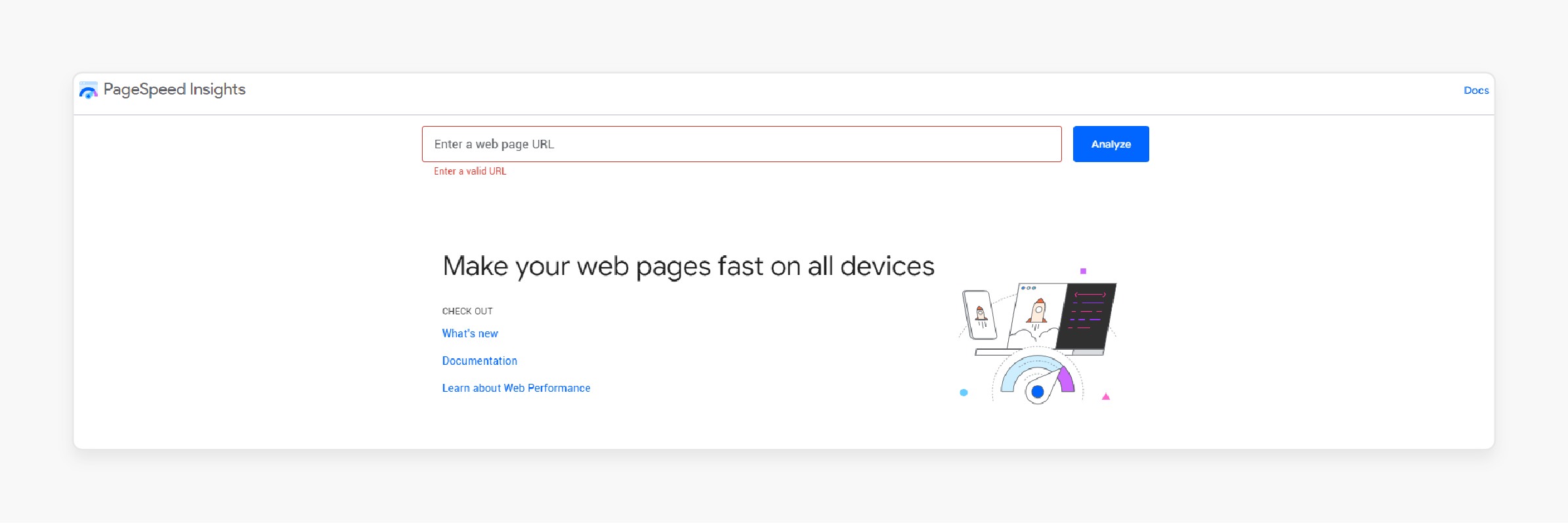
Google PageSpeed Insights grades website performance on a scale from "1 to 100" points. The higher the score, the more optimized your site is. A score "above 85 points" indicates excellent performance. Anything "below 85" means you need to run Magento speed optimization immediately. This tool helps identify store performance issues for both mobile and desktop versions.
PageSpeed Insights provides scores and recommendations for both mobile and desktop versions. It includes key benefits for improving Magento optimization:
- Core Web Vitals analysis: Measures Largest Contentful Paint (LCP), First Input Delay (FID), and Cumulative Layout Shift (CLS).
- Opportunity identification: Highlights specific areas for improvement, such as JavaScript minification.
- Diagnostics: Provides detailed information on server response times, resource caching, and more.
Leverage PageSpeed Insights to track your Magento website performance audit over time. Ensure alignment with Google's performance best practices. This tool maintains optimal performance and addresses any issues promptly.
When using Google PageSpeed Insights, focus on the 'Opportunities' and 'Diagnostics' sections.
For example, if it suggests 'Eliminate render-blocking resources', defer non-critical JavaScript and inline critical CSS. If it recommends 'Serve images in next-gen formats', consider converting your images to WebP format. This can reduce image sizes by "25-35%" compared to JPEG or PNG without losing quality.
2. GTmetrix
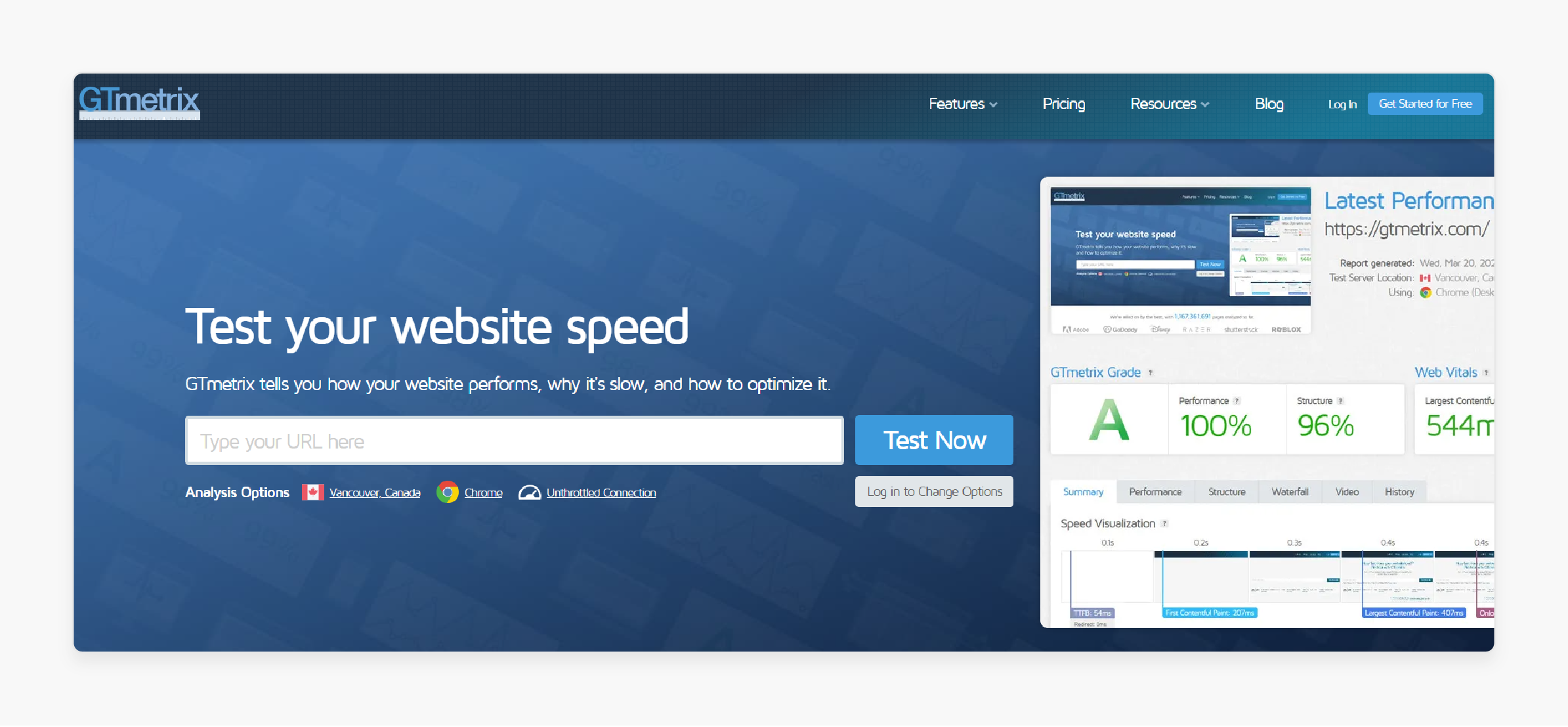
GTmetrix offers a detailed analysis of your Magento store's performance. It provides insights that complement other tools. Include a waterfall chart to visualize the loading sequence of all page elements. It helps you identify bottlenecks in resource loading. It also provides a page load time analysis with a breakdown of the following:
- Time to first byte
- DOM loading
- Full page load
GTmetrix offers YSlow recommendations for further performance optimization based on Yahoo's performance rules. Conduct regular performance audits and track improvements for overall performance.
GTmetrix assigns page results in grades from "A" to "F". The tool also offers seven different locations for testing. Its reports are subdivided into five sections:
- PageSpeed results
- YSlow results
- Waterfall breakdown
- Video
- History
Other tools like WebPageTest and Yellow Lab Tools can provide performance summaries. These tools are essential for identifying and addressing Magento 2 speed optimization. They ensure your site runs smoothly and efficiently.
3. New Relic
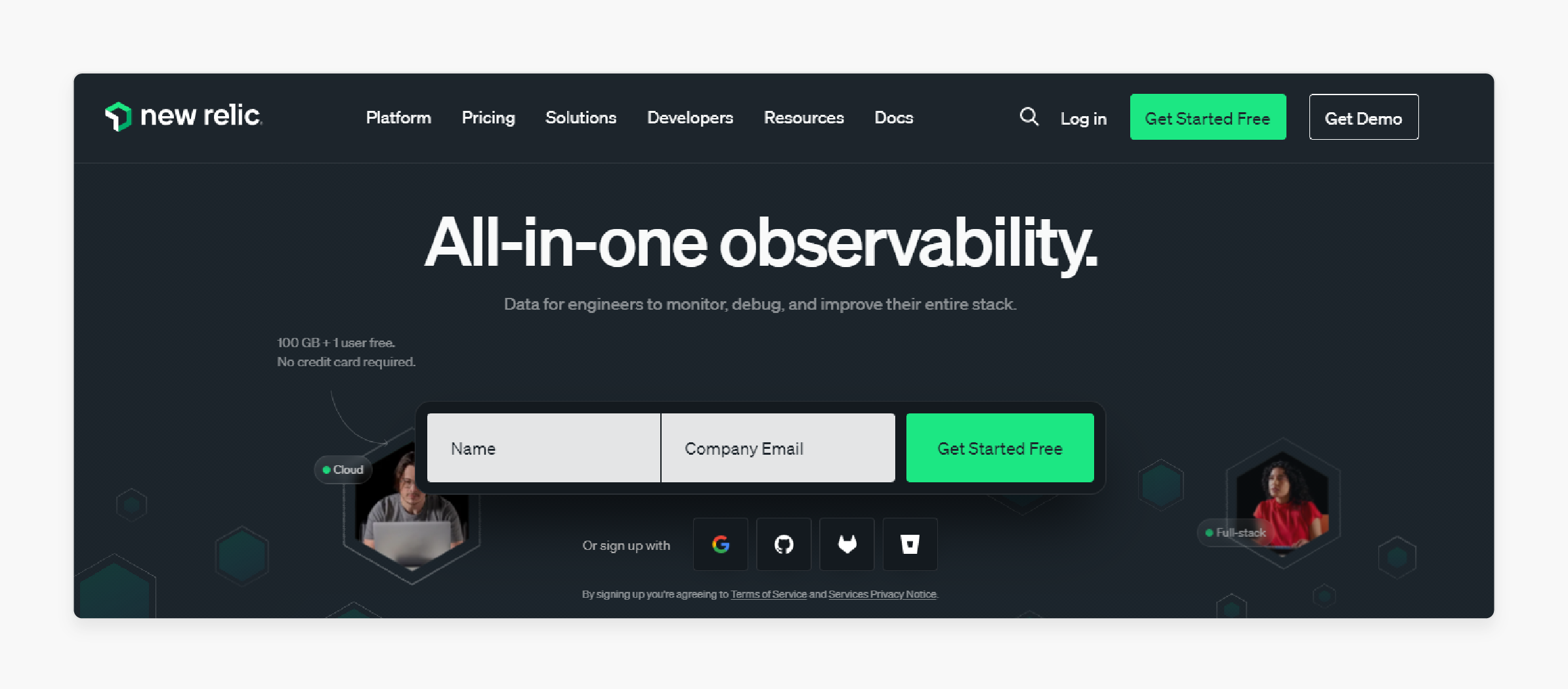
New Relic offers enterprise-grade application performance monitoring (APM). It is particularly useful for complex Magento implementations. Key capabilities for Magento performance analysis include real-time monitoring. This allows you to track performance metrics across your entire Magento stack.
Identify bottlenecks in PHP execution, database queries, and external services. Transaction tracing helps analyze individual user interactions to pinpoint website speed. It also helps trace slow transactions across different layers of your Magento application. Also, infrastructure monitoring tracks server-level metrics of your managed Magento hosting provider environment.
New Relic's comprehensive insights can be invaluable for large-scale Magento stores. Utilizing its detailed performance analysis enhances the efficiency and speed of your store. It ensures a better user experience and improved site performance.
4. Magento Profiler
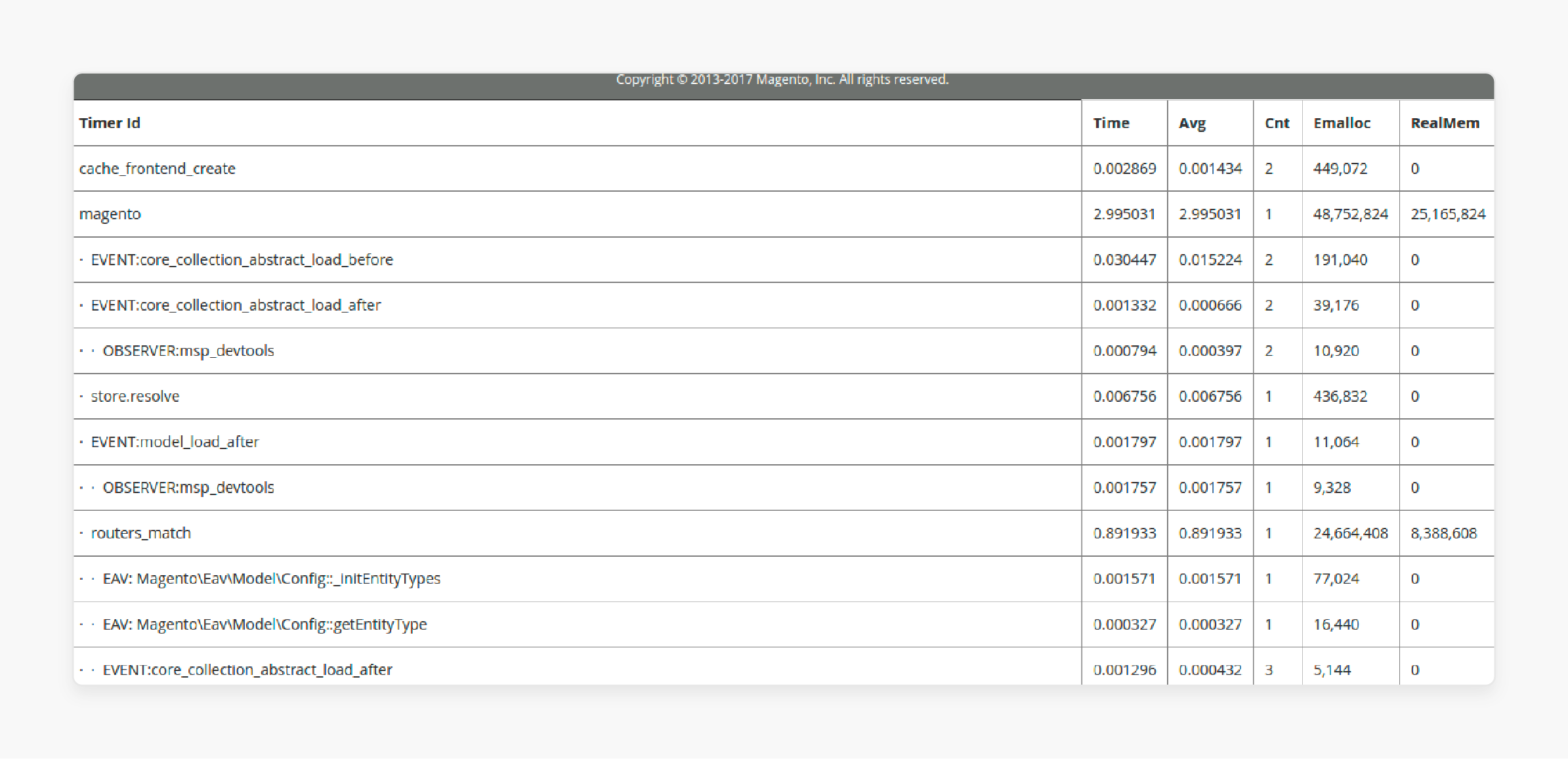
The built-in Magento Profiler is a powerful tool for developers and administrators. It helps you analyze the platform's internal performance. Include block-level execution times to optimize template and layout files. They help identify slow-rendering Magento blocks. It also offers database query analysis to pinpoint slow or repetitive database queries. This allows you to optimize database interactions in custom modules.
Memory usage tracking monitors PHP memory consumption and identifies memory-intensive operations. Remember to disable the Magento Profiler in production environments. Utilize this tool during the development and testing phases. Identify and address critical issues before they affect the live site.
5. Blackfire
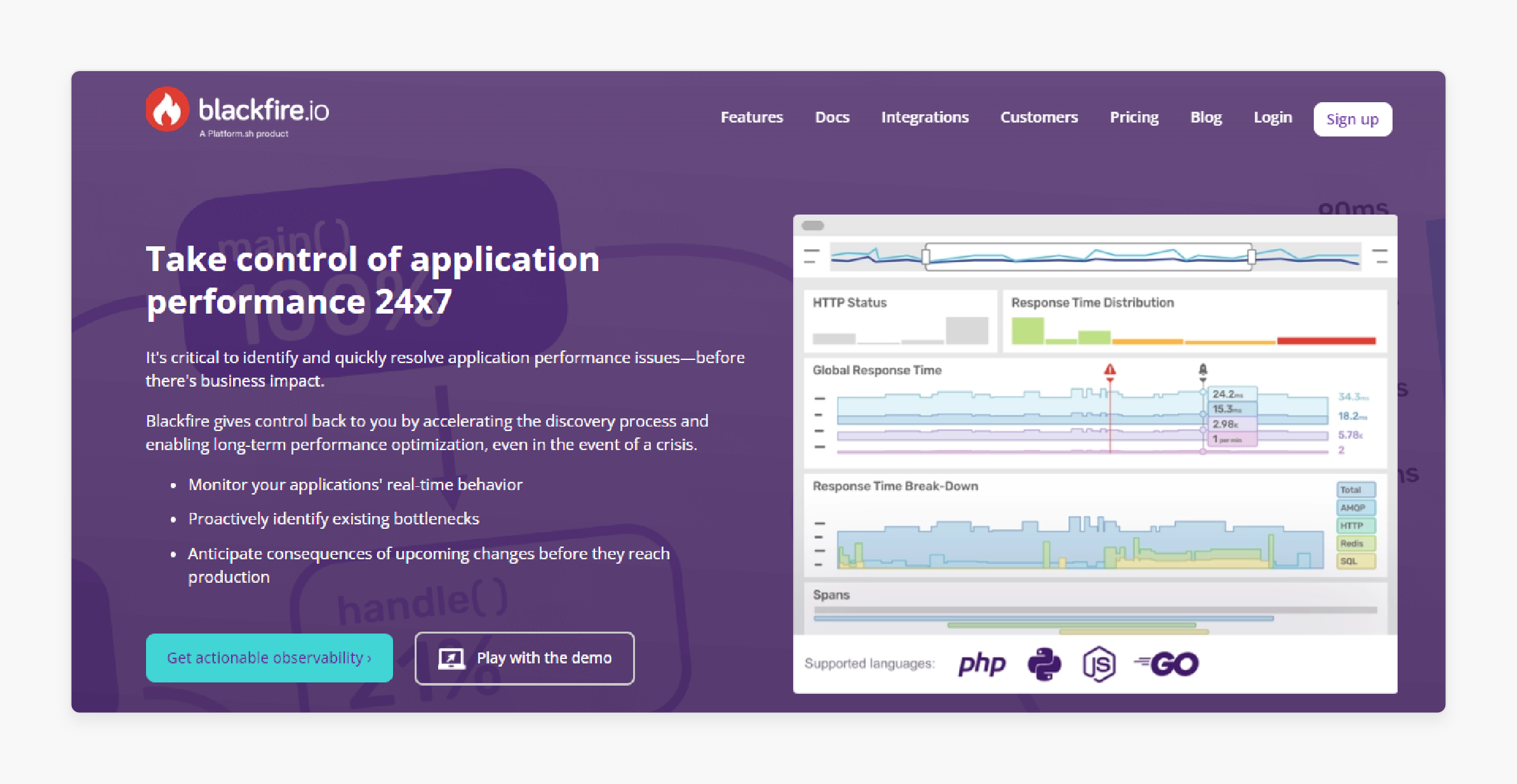
Blackfire offers deep insights into PHP performance. Include code-level profiling to identify performance bottlenecks at the function and method level. It analyzes CPU time, memory usage, and I/O operations.
Comparison profiles allow developers to compare performance between different code versions. This helps to identify regressions or improvements in performance. Also, continuous profiling integrates with CI/CD pipelines for ongoing performance monitoring. It allows developers to set performance budgets and receive alerts on violations.
Leverage Blackfire to optimize custom Magento modules. Also, ensure that code changes do not negatively impact performance. This tool maintains and improves the efficiency of your custom Magento developments. It ensures a seamless and high-performing user experience.
Best Practices For Preventing Magento Site Performance Optimization Issues
| Best Practices | Why It Matters | How to Implement |
|---|---|---|
| Use a Content Delivery Network (CDN) | Speeds up global access to your Magento store | Integrate with services like Cloudflare or Akamai. |
| Optimize Images | Reduces page load time | Use tools like TinyPNG or enable Magento's built-in image optimization. |
| Enable Magento's Full Page Cache | Dramatically improves page load speeds | Configure in Magento Admin under System > Cache Management. |
| Implement Redis for Session Storage | Reduces database load and improves response times | Set up Redis and configure in Magento's env.php file. |
| Regularly Update Magento | Ensures you have the latest performance improvements | Schedule regular updates and test in staging first. |
| Minimize Extensions | Reduces potential conflicts and overhead | Regularly audit and remove unnecessary extensions. |
| Use PHP 7.4 or higher | Offers significant performance improvements | Upgrade the PHP version on your server. |
| Optimize JavaScript and CSS | Reduces file sizes and improves load times | Use Magento's built-in minification or tools like Grunt. |
| Implement Proper Indexing | Speeds up database queries | Configure and maintain indexes in Magento Admin. |
| Use Varnish Cache | Provides faster caching than built-in full page cache | Set up Varnish on your server and configure it in Magento. |
FAQs
1. How can a Magento developer optimize the performance of my store?
A skilled Magento developer can implement various techniques to optimize Magento. Examples include code optimization and database tuning. You can leverage Magento's built-in features to significantly speed up Magento 2 optimization technique.
2. Does upgrading to the latest version of Magento improve performance?
Yes, upgrading to the latest Magento version often improves Magento performance. Each new release typically includes optimizations and bug fixes. This can improve your store's speed and efficiency.
3. What role does image optimization play in Magento website loading times?
Image optimization is essential for Magento site speed. Properly optimized images reduce page load times, improving the performance and user experience. Magento offers built-in image optimization tools to significantly speed up the performance of your Magento store.
4. How often should I run speed tests on my Magento store?
It is recommended to run speed tests regularly, ideally at least once a month. This helps you optimize your Magento store performance consistently and identify any issues early on.
5. Can Magento extensions impact my store's performance?
Yes, while extensions can add functionality, they can also affect performance. It is important to choose well-coded, compatible extensions. Also, regularly review and update them to maintain better performance and speed.
6. What is Magento TTFB optimization in Magento, and why is it important?
TTFB (Time To First Byte) makes Magento. Lowering TTFB can significantly speed up the performance of the Magento platform. Having this integrated with Magento can speed up your website through default Magento speed optimization extensions.
7. How can I leverage Magento's full-page cache to improve performance?
Magento full-page cache is a built-in feature that stores fully rendered page content. Magento performance optimization guide can prevent slowing Magento installation.
Summary
Resolving Magento performance issues can help you keep up with customer demands. Addressing these issues helps Magento store owners to:
- Optimize slow page loads, database inefficiencies, and server issues.
- Implement image optimization, caching, and code optimization.
- Perform regular maintenance.
- Choose the right hosting plan for ongoing optimization.
Have a clear roadmap to enhance your store's efficiency by improving performance challenges with Magento optimized server.






